Project Management Assignment: Identification Of Talent Management Strategies
Question
Task:
Project Management Assignment: You are the Human Resources Director for a company/organization of your choice.
You have been given the challenge to investigate what talent strategies the best companies use to attract and retain people. The findings will then need to be analysed as to whether or not they could be effectively used by your firm.
As the project manager you are seeing that the project is completed well in time in order to be presented at the Board on 22.6.2021
Task:
You are to:
- Establish your aims and objectives for the project. Outline objectives and timeframes based on the scenario set.
- Produce an appropriate project management plan that includes relevant actions to meet objectives and timeframes.
- Conduct research to generate knowledge which will form the basis for analysis of the scenario posed in the brief.
- Analyse your findings and draw conclusions to form the basis for recommendations.
- Present and produce your project in an appropriate manner for the intended audience.
- Communicate your recommendations in an appropriate manner for the intended audience.
- Complete a performance review that addresses the following:
- The success of the project and its usefulness in supporting organisational performance.
- Your own performance.
Evidence required:
- A complete project management plan with logbook
- A small scale research
- Performance review
Answer
Introduction
In this report on project management assignment, the talent management strategies and importance of it have been focused on. Talent management is one of the most vital parts of business organisations. Not only the human resource management, but all the other line managements should focus on this context. The skills and knowledge of individuals make them better professionals. Talented professionals are highly beneficial for a company as they make the company successful and growing in the respective market (Francis, 2017). Thus, managing the employees and their skills and the concern of their wellbeing in the organisational context is known as talent management. There are different models and multiples steps accordingly in the talent management process. This report focuses on a small online travel and tourism company, ‘We Are Holidays’ and its talent management process. There are different strategies that a company can take to have success in the market. This projectof research and identification of best practices for talent management will help the company to develop and use effective talent management strategies in the organisation. Thus, it will be able to have better market performance and to have overall business growth. This report includes the plan for this project followed by a research and analysis segment for the project. Proper recommendations have been developed for the company based on the research and analysis. Also, a performance evaluation is made at the end of the paper, followed by a suitable conclusion. Thus, the success of the paper will be beneficial for the mentioned travel and tourism company.
Aim and Objectives
In this part of the paper, the aim and the objectives of the project is needed to be set. This will help the researcher to be on the right track while developing and conducting the project. This will also help to get the desired project outcome.
- This project aims to recommend the best practices and strategies for talent management in the company.
The objectives of a project help to fulfil the aim. The objectives for this project are;
- To develop a proper understanding of the talent management process
- To identify the best practices of talent management in the organisations
- To develop recommendations for the company to have better talent management in the organisation.
Project Plan
In this part of this paper, the project plan has been placed briefly. There are several parts of the plan that will be beneficial for conducting and completing the project successfully.
Activity Log
Multiple activities are necessary to complete this project. Description of the activities is provided in this segment in a tabular format. This will further help to develop the entire project plan.
|
SL No. |
Activity Name |
Description |
|
1 |
Requirement Collection |
This is the first activity of this project to help the project manager have the necessary information and data regarding the project requirement. For this, the company requirements are analysed by the project team. |
|
2 |
Documentation |
Proper documentation of the requirements and other plans are needed. This is a vital activity of this project management. |
|
3 |
Communication Management |
The manager needs to maintain proper communication throughout the project. Thus, maintaining communication is an essential activity in this context. |
|
4 |
Risk Management |
Risks of the project are identified and mitigated in this activity. |
|
5 |
Data collection |
Relevant data and information are collected in this activity that further helps the project to have the desired outcome. The proper methodology is followed in this activity. |
|
6 |
Data Analysis |
As per the methodology, the collected data and information are analysed to develop understandings and concepts. |
|
7 |
Developing Recommendations |
With the help of this activity, the recommendations are developed to make better talent management in the company. |
|
8 |
Developing conclusion and Closure of the project |
This is the last activity of the project that |
Cost
The cost of the project is one of the significant constraints of the triple constraint concept. The cost of a project is needed to be estimated before starting the project. The project owners need to approve this to start the activities (Susilowatiet al., 2021). Different costs are estimated for the different activities of this project. These are mentioned below. The total cost of the project will be determined by adding all the costs of the activities.
|
SL No. |
Activities |
Cost (in USD) |
|
1 |
Requirement Collection |
984 |
|
2 |
Documentation |
667 |
|
3 |
Communication Management |
1078 |
|
4 |
Risk Management |
869 |
|
5 |
Data collection |
2376 |
|
6 |
Data Analysis |
1134 |
|
7 |
Developing Recommendations |
700 |
|
8 |
Developing conclusion and Closure of the project |
300 |
|
|
Total |
7478 |
The costs against all the project activities are mentioned in the above table. It can be observed that the total estimated cost for this project is 7478 USD. This cost estimation will be tried to be maintained while developing the project.
Scope
The scope is one of the significant constraints of the three constraints of project management. The scope of the project says what is included in the project and what is not. In this project, all the mentioned activities are included in the project. The project's main scope is the talent management process and practices (Barbalhoet al., 2017). Thus, the scope of this project is clearly defined.
On the other hand, developing the talent management system in the company is not included in this particular project. Thus, this is not the scope of this project. Also, evaluation of project performance and project manager performance is not part of the project. Thus, being clear about the project is beneficial for the project manager.
Timeline
Time is the third constraint according to the Project Management Triangle. This constraint has a massive impact on the project process and the project quality. The total time required for the project is estimated here. All the different activities of the project will take different time (Hassan, Adeleke and Taofeeq, 2019). the project manager can maintain a proper timeline to make the project more efficient and capable of completing a timely. Maintaining the delivery time of the project is highly important. Thus, the project timeline will help the project manager and the project team complete the project with time efficiency.
|
Activities |
Start Date |
End Date |
Duration (days) |
|
Requirement Collection |
5-1 |
5-5 |
4 |
|
Documentation |
5-6 |
5-14 |
8 |
|
Communication Management |
5-14 |
6-7 |
24 |
|
Risk Management |
5-20 |
6-7 |
18 |
|
Data collection |
5-15 |
5-29 |
14 |
|
Data Analysis |
5-30 |
6-3 |
4 |
|
Developing Recommendations |
6-3 |
6-6 |
3 |
|
Developing conclusion and Closure of the project |
6-7 |
6-10 |
3 |
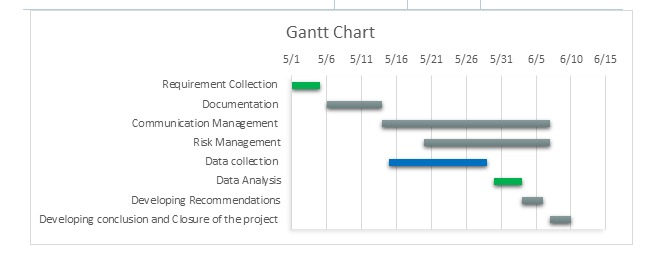
Figure 1: Gantt chart
(Source: Made by Author)
WBS
Work breakdown structure is another crucial part of planning the project. The project plan remains incomplete without developing a proper work breakdown structure of the project. This will help the project manager to manage the works and responsibilities of the team. The project team will also be clear about their tasks and responsibilities.
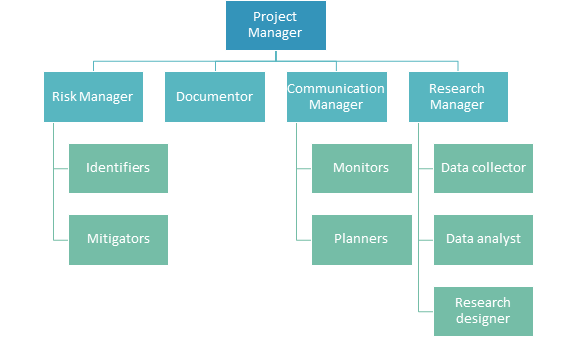
Figure 2: Work-breakdown-structure
(Source: Made by Author)
Quality
As per Maheshwariet al. (2017), quality is related to the triple constraint triangle of project management. All three constraints are directly influential on the quality of the project. In this project, the quality will be maintained by maintaining the balance between the three constraints of this project. Proper planning is a part of ensuring the quality of a project. All the activities will be checked and done to have the best possible quality.
Communication
According to Francis (2017), communication is a vital part of a project. Proper communication is needed to be maintained throughout the entire project to complete it correctly. There are different channels of communication that can be used in this project. The team members will be communicated through email and messaging services. There will be a common in-house channel for online communication. This will help the project to be completed correctly as it improves teamwork. Besides, external stakeholders of this project will be communicated through email and messaging service. Thus, the entire project communication is maintained to make the project successful.
Risks
Risk Management helps a project to be successful in the end by avoiding and mitigating the potential risks of the project. There can be different types of possible risks of a project. These risks can be responded to properly with effective risk management. A few possible risks have been identified for this project (van Zyl, Mathafena and Ras, 2017). The mitigation plan is also stated briefly. This helps the project to avoid unexpected situations and failures.
|
SL No. |
Risks |
Mitigation Plan |
|
1 |
Lack of Communication |
This risk can be mitigated with the help of monitoring and making communication active by the manager and supervisors. Effective communication rules will help to make the project efficient and successful. |
|
2 |
Skills gaps of the team |
This is an essential part of the project. The skills of employees cannot be compromised in this context. This can harm the project (Chou and Chiu, 2021). Hence, the team members will be trained and developed with a short training focused on this project. |
|
3 |
Increased cost |
This risk can be mitigated by having an additional budget from the initial day. The estimation process can be repeated with better accuracy. This will also be beneficial in this case. |
|
4 |
Increased time |
Maintaining the schedule is highly important. The projects should strictly follow the timeline. Monitoring can help in this case. |
|
5 |
Ethical Issues in Data collection |
Data collection is subject to ethical values. Also, this can cause legal issues in the project (van Zyl, Mathafena and Ras, 2017). Thus, proper ethical guidelines will be developed to be maintained by the project team. Transparency is a must-maintained factor throughout the entire project. |
Resources
The resources of this research are identified and highlighted in this last part of the project plan. There are internal and external resources of this project. The resources are discussed in the below table.
|
Type |
Resources |
Discussion |
|
Internal Resources |
Budget |
The company will provide this to have the recommendations for talent management. |
|
Human Resource |
This resource includes the team members and managers of this project. |
|
|
Technical Resource |
The technical requirements, such as computers, software, communication technologies, are provided by the company (Francis, 2017). |
|
|
External Resources |
Survey Participants |
They are the external resources that help the project to have primary and quantitative data. |
|
Collected data from journals, articles, websites, research papers, etc. |
These are also external resources that help to have relevant qualitative information on talent management and its best practices and strategies. |
Research
In this part of this paper, small-scale research has been done. For this, both qualitative and quantitative data have been collected by the project team. These data and information help to suggest the best practices for talent management in the company.
Benefits of Talent Management
According to Mitosis, Lamnisos and Talias, (2021), talent management is one of the most critical parts of a business. Without proper talent management, there are several faults and failures observed in businesses. Many reasons work behind the decision of having proper and effective talent management in an organisation. Talent management has a direct positive influence on organisational performance. It has been observed that the companies with better talent management cause the better performance of the businesses in the market. There was a study by the HackettGroup that was identified that one company that focuses on talent management could increase its earnings in the market. Also, there is another similar study by IBM that founds the same. The study's main finding is that a company with less talent management is always behind that with higher talent management. Many factors such as leadership, learning capability, workforce, etc., are vital in talent management.
Talent Management model
According to King and Vaiman (2019), the input of a talent management model is organisational strategies. These are used to manage talents with the help of a management model. The output of this model is organisational performance. There are five phases of the talent management model. Planning for the management process in the first phase of this model. This includes different activities such as knowing the business requirements and strategies appropriately. Practical evaluation is done in this phase, followed by a proper workforce plan. The next phase of the talent management process is attracting new talents to the business. There are several ways to do that. Marketing is one of the most common ways to attract new talents. Also, the companies do compelling employee value proposition (Naim and Lenka, 2017). This attracts talented professionals to the companies. There are renowned organisations such as Apple and Google. They are investing high in talent management to acquire and use new talents and make the opportunity for both the talents and the organisation for satisfactory growth. The companies sometimes go with consultants and freelancers in this phase. The third phase of the model is the developing phase. At this phase, the talents are developed with proper training and development arrangements. Performance appraisals are also vital in this phase. Thus, the acquired talents are developed as per the company needs.
According to Poisat, Mey and Sharp (2018), acquiring the talents and retaining them in the organisation is a challenging part of the talent management process. The manager should develop effective strategies for this. Generally, the manager needs to focus on the cultural aspects. The cultural backgrounds of the employees are needed to be considered. Also, a healthy organisational culture is developed by the companies to retain the talents. Rewards and remuneration policies can be changed to improve talent retention of the companies.
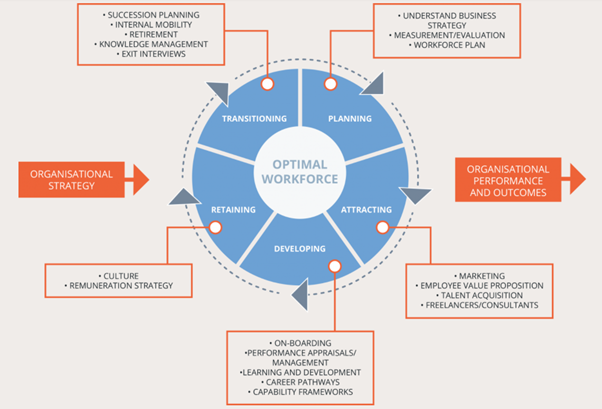
Figure 3: Talent management model
((Source: van Zyl, Mathafena and Ras, 2017)
Primary data collection Process
In this small-scale research, primary data will be collected to have quantitative data for the research. There are different techniques to collect primary data. The survey is one of the most common and effective processes to collect primary quantitative data for research. In this case, also, the survey is selected as the data collection tool. Purposive sampling is suitable for this research (Serra, Psarra and O’Brien,2018). Ten respondents are an HR manager and have experience in talent management in large and medium companies. There is a set of five questions in the questionnaire of this survey. The survey has been designed as an online survey. The link to the survey is shared by email and messaging services. The questionnaire is provided below.
Questionnaire
- Do you think employee satisfaction is vital in talent management?
- What is the most crucial factor of talent management?
- According to you, which is the most influential factor for talent retention?
- What should be the leading approach for better talent management?
- What can be the best way to attract new talents?
Survey
|
Question 1 |
||
|
Options |
Response |
Percentage |
|
Yes |
8 |
80 |
|
No |
2 |
20 |
|
May be |
0 |
0 |
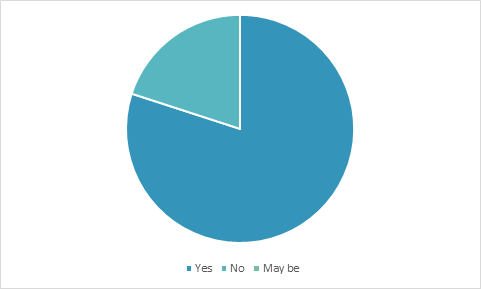
|
Question 2 |
||
|
Options |
Response |
Percentage |
|
Acquisition |
2 |
20 |
|
Development |
5 |
50 |
|
Retention |
3 |
30 |
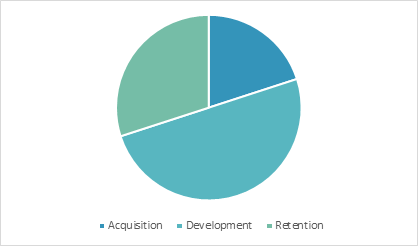
|
Question 3 |
||
|
Options |
Response |
Percentage |
|
Remuneration strategy |
6 |
60 |
|
Rewards |
1 |
10 |
|
Organisational Culture |
3 |
30 |
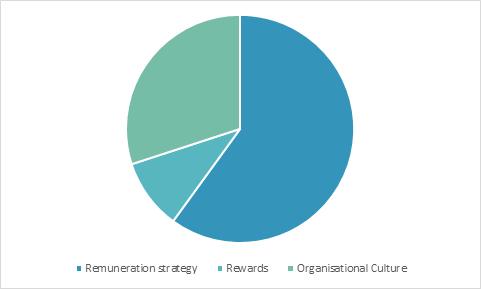
|
Question 4 |
||
|
Options |
Response |
Percentage |
|
Democratic |
7 |
70 |
|
Autocratic |
2 |
20 |
|
Servant leadership |
1 |
10 |
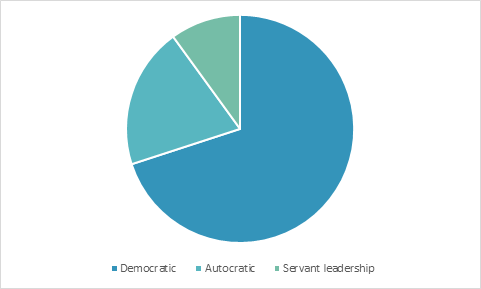
|
Question 5 |
||
|
Options |
Response |
Percentage |
|
Marketing |
3 |
30 |
|
Better salary |
3 |
30 |
|
Attractive job profile |
4 |
40 |
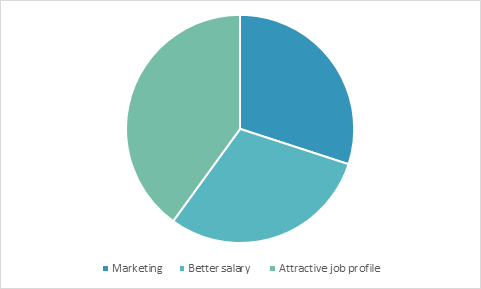
Analysis
In this part of the study, an analysis of the research has been done. For this paper, root cause analysis is the best-fitted one. The qualitative data is analysed in the first part, followed by the analysis of the quantitative data.
From the research data, it can be observed that there are many benefits of using talent management. The overall organisational performance is improved with the help of this. The companies can achieve better organisational value. This can have a long-term positive impact on the organisations. Thus, from the research, it is clear that talent management is needed to succeed in the markets. From the talent management model, it can be interpreted that the process is not a simple one. It has multiple phases with multiple activities in each of the phases (Sharma, 2017). Thus, proper talent management needs to be planned clearly to avoid risks and failures. Understanding the business and the employee requirements is essential for effective talent management.
The survey with the ten experts on this subject helps find out the best effective practices for talent management. This will help to develop the recommendations further. From the first question, it can be clearly observed that 80% of the respondents have stated that employee satisfaction is a vital part of talent management. From this, it can be said that organisations need to focus on employee satisfaction. This will help to have better talent management in the organisation. From the response to the second question, there are close calls for the options as the critical factors of talent management. Half of the participants have selected the development of talents as the most vital part of the talent management process.
On the other hand, 30% has stated that retention is the most crucial factor. According to 20% of the participants, the acquisition helps in managing talents in the organisations. The third question focuses on talent retention. 60% of the participants think that remuneration strategy is the most influential factor on retention. On the other hand, 30% of participants think that organisational culture has a considerable influence in this context. The fourth question is about the leadership approaches to have better talent management. Most of the participants has selected democratic leadership as the best suitable for talent management. The last question emphasises the way to attract talents. There are close calls in this case also. 40% of the participants have gone with the option "attractive job profile". On the other hand, for the other two options, salary and marketing have got 30% each. Thus, all these three factors can be considered necessary in this case.
Recommendation
From the research and analysis, different best practices of talent management are identified. These are beneficial in developing recommendations for this company. Thus, the following recommendations are developed.
- Clear Expectations and Goals: The company should have clear goals and objectives for talent management. The manager and the leaders need to know the result of the talent management and what is needed to this. Thus, with a clear vision of the requirement and procedures, it will be comfortable to develop an effective talent management system in the company.
- Professional development opportunity: The company should provide opportunities to its talents to develop themselves professionally. This can be done with better learning opportunities in the workplace. Two-way communication should be used in the workplace to develop a learning environment. Also, the company should arrange professional skill development sessions for the selected employees as per the organisational policies.
- Appraisals, Recognition and Rewards: The company should plan for better appraisal processes for the talents. Rewards should be provided for good performances. Also, recognitions can help in talent retention in the company.
- Know the company culture: The culture of the organisation is essential in this context. The managers should have a clear understanding of the culture of the company. Thus, they will be able to develop effective plans and management strategies for the organisation's talents.
- Salary and job profile: The company should develop an attractive salary offering to the new talents and an attractive job profile. Combining these two will surely help the company get suitable and effective talents for better performance in the market.
Performance Evaluation
This part of this paper is a reflective evaluation part where a reflection on the project performance and my performance as an HR manager of the company is highlighted.
First of all, I would like to say about the project performance. The project team has provided good performance in the overall project timeline. There are some issues in the project, such as communication and budget estimation (Whysall, Owtram and Brittain, 2019). In these segments, the team has not performed its best. On the other hand, the survey process has been excellently handled by the project team. Thus, the overall performance of the project is entirely satisfactory.
About my performance as an HR manager, I can say I have used my skill of effective listening and problem-solving in managing this entire project. I have been able to motivate the team members of this project to arrange the survey. On the other hand, I feel that I could have improved my decision-making skill. My leadership skill also requires some improvement in further projects. I will try to improve myself as per the experience of this project.
Conclusion
This paper consists of a project plan and a research project to identify the best practices for talent management. Both qualitative and quantitative research has been done on a small scale. With the help of the analysis, some of the suitable and best practices are suggested to the company to improve the talent management in the organisation. This is being expected to be beneficial for the company and others based on the same.
Template for evidence
collection to be attached with the report by the learner:
|
Project Logbook for the chosen organisation: |
|
|
Name of the learner: |
Name of the Supervisor: |
|
Project Title: Identification of Best Practices for Talent Management |
Date: |
|
Update of weekly research/ tasks achieved (Account for a minimum of six weeks with dates) Ø What have you completed? Week 1 I have completed collecting requirements Week 2 Documentation Week 3 Communication Planning, Project Planning Week 4 Data Collection Week 5 Analysis Ø Did you fulfil the Task requirements?
Week 1 Yes Week 2 Yes Week 3 No Week 4 Yes Week 5 Yes
Ø Are you on track and within deadlines set? Week 1 Yes Week 2 No Week 3 Yes Week 4 Yes Week 5 No
Ø Did you need to make any changes to your project management plan? Week 1 No Change Required Week 2 No Change Required Week 3 No Change Required Week 4 No Change Required Week 5 No Change Required
|
|
|
Any risks and/or issues identified? Ø Did you identify risks/issues with a lack of skills required for undertaking research tasks?
Week 1 Insufficient Information Collected Week 2 No Issues Week 3 Lack of communication Week 4 Lack of planning Week 5 Timeline risk
Ø Did you identify any additional risks/issues that have an impact on the project management plan? Week 1 No Issues Week 2 Lack of understanding Week 3 Lack of effective listening Week 4 No issues Week 5 Lack of analytical skills
|
|
|
Problems encountered Ø What barriers did you face? Week 1 Communication Week 2 Communication Week 3 Budget Week 4 Communication Week 5 Planning
Ø How did you overcome them?
Week 1 Team meeting Week 2 Team meeting Week 3 Redevelopment of budget Week 4 Team meeting Week 5 Skill development
|
|
|
New Ideas and change of project direction
Week 1 Not Required Week 2 Not Required Week 3 Not Required Week 4 Not Required Week 5 Not Required
|
|
|
What Have I learnt about myself this week? Ø How did I feel when I had to deal with tasks/problems? Week 1 Uncomfortable Week 2 I felt that I need improvement Week 3 Need improvement Week 4 Impatience Week 5 Determined
Ø Did I find it useful to complete the tasks? Week 1 No Week 2 Yes Week 3 Yes Week 4 No Week 5 Yes
Ø How well have I performed? What did I contribute? Week 1 I have observed the works Week 2 I helped in documenting Week 3 I have planned the communication Week 4 I designed the survey Week 5 I helped in the analysis
Ø What can I improve on next week? Week 1 Teamworking Week 2 Planning Week 3 Planning Week 4 Analysis Week 5 Analysis
Ø How might this learning apply in the future? Week 1 Can help in working with different teams Week 2 Helps to avoid risks and failures Week 3 Helps to avoid risks and failures Week 4 Helps to develop proper understanding and outcomes Week 5 Helps to develop proper understanding and outcomes
|
|
|
Tasks planned for next week Ø Which tasks are a priority? Week 1 Week 2 Week 3 Week 4 Week 5
Ø Have you set aside sufficient time for completion? Week 1 Documentation Week 2 Communication Plan, Project Plan Week 3 Data Collection Week 4 Analysis |
|
|
Project plan status to date On |
|
|
Supervisor comments to address
|
|
|
Signature of the Supervisor and date:
|
|
Template for Performance Review Template to be attached with the report by the learner:
|
1. What was the project supposed to accomplish?
The project was supposed to find the best practices of talent management.
|
|
2. Did the project succeed in its aims/ how do you know? Specifically, please outline any evaluation and assessment undertaken.
The project has been successful. Recommendations have been developed for the company with the help of project results.
|
|
3. What things do you think worked well and why? Evaluate all aspects of the project (e.g. initial inception, project activities and project outcomes) from a range of perspectives.
The survey process was well developed and arranged by our team. No ethical or technical issues were there. The activities have been done properly. However, there was a lack of skills and understandings observed in many stages. Documentation was not perfect initially. The analysis of the data went challenging. The outcome of the project helped to fulfil the project objectives.
|
|
4. What problems emerged during the project, and how were they tackled? Was there timely identification of issues and resolution during the project process? The budget plan was not accurate in this project. This was deal by having redevelopment of budget. This needed re-analysis. Communication was a huge issue in this project. I have arranged multiple team meetings to sort out these issues. Also, planning was an issue. Requirement collection was done properly to do this. Skill development seasons helped to deal with the problems. |
|
5. What did you learn from undertaking the project? I have learnt teamwork, planning, management and leadership from this project.
|
|
6. How would you rate your performance as a management consultant leading the project?
I would rate myself six on a scale of 10. I feel I need more improvements in the further days.
|
|
7. What strengths and weakness of your performance did you identify?
My major strength is my problem-solving capability My major weakness is leadership
|
|
8. How will this information and support your continuous professional development?
With the help of this, I will develop recommendations and action plan for me to develop my professional skills further.
|
Reference List
Barbalho, S. C. M., da Silva, G. L., and de Toledo, J. C. (2017). The impact analysis of functions of Project Management Office on the performance of triple constraint of new-product development projects. Dirección y Organización, (61), 19-31.
Chou, J. S., and Chiu, Y. C. (2021). Identifying critical risk factors and responses of river dredging projects for knowledge management within the organisation. Journal of Flood Risk Management, 14(1), e12690.
Francis, G. (2019). Enterprise Risk Management (ERM): Key Risks, Responses and Applications.https://www.soa.org/globalassets/assets/files/resources/essays-monographs/2019-erm-symposium/mono-2019-erm-francis.pdf
Hassan, A. K., Adeleke, A. Q., and Taofeeq, D. M. (2019). The effects of project triple constraint on Malaysia Building Projects. Social Science and Humanities Journal, 1222-1238.https://core.ac.uk/download/pdf/220098792.pdf
King, K. A., and Vaiman, V. (2019). Enabling effective talent management through a macro-contingent approach: A framework for research and practice. BRQ Business Research Quarterly, 22(3), 194-206.https://journals.sagepub.com/doi/pdf/10.1016/j.brq.2019.04.005
Maheshwari, V., Gunesh, P., Lodorfos, G., and Konstantopoulou, A. (2017). Exploring HR practitioners’ perspective on employer branding and its role in organisational attractiveness and talent management. International Journal of Organizational Analysis.http://eprints.leedsbeckett.ac.uk/id/eprint/4531/1/Employer%20Branding%20paper%20accepted.pdf
Mitosis, K. D., Lamnisos, D., and Talias, M. A. (2021). Talent management in healthcare: A systematic qualitative review. Sustainability, 13(8), 4469.https://www.mdpi.com/2071-1050/13/8/4469/pdf
Naim, M. F., and Lenka, U. (2017). Talent management: A burgeoning strategic focus in the Indian IT industry. Industrial and Commercial Training.https://www.academia.edu/download/56487851/TM_BURGEONING.pdf
Poisat, P., Mey, M. R., and Sharp, G. (2018). Do talent management strategies influence the psychological contract within a diverse environment?. SA Journal of Human Resource Management, 16(1), 1-10.https://sajhrm.co.za/index.php/sajhrm/article/download/1044/1544
Serra, M., Psarra, S., and O’Brien, J. (2018). Social and physical characterisation of urban contexts: Techniques and methods for quantification, classification and purposive sampling. Urban Planning, 3(1), 58-74.https://www.academia.edu/download/56142587/1269_-_Proofreading_final.pdf
Sharma, G. (2017). Pros and cons of different sampling techniques. International journal of applied research, 3(7), 749-752.https://www.academia.edu/download/58765080/Pros_and_cons_of_sampling.pdf
Susilowati, M., Kurniawan, Y., Prasetiya, H. P., Beatrix, R., Dewa, W. A., and Ahsan, M. (2021, March). How to manage scope, time and cost of the project management plan to develop a manufacturing information system. In IOP Conference Series: Materials Science and Engineering (Vol. 1098, No. 6, p. 062006). IOP Publishing.
van Zyl, E. S., Mathafena, R. B., and Ras, J. (2017). The development of a talent management framework for the private sector. SA Journal of Human Resource Management, 15(1), 1-19.https://sajhrm.co.za/index.php/sajhrm/article/download/820/1183
Whysall, Z., Owtram, M., and Brittain, S. (2019). The new talent management challenges of Industry 4.0. Journal of management development.http://irep.ntu.ac.uk/id/eprint/35879/1/13456_Whysall.pdf












